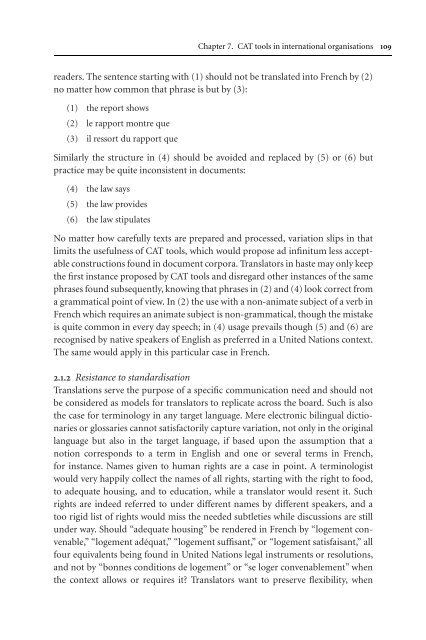Topics in Language Resources for Translation ... - ymerleksi - home
Topics in Language Resources for Translation ... - ymerleksi - home
Topics in Language Resources for Translation ... - ymerleksi - home
- No tags were found...
You also want an ePaper? Increase the reach of your titles
YUMPU automatically turns print PDFs into web optimized ePapers that Google loves.
Chapter 7. CAT tools <strong>in</strong> <strong>in</strong>ternational organisations 109readers. The sentence start<strong>in</strong>g with (1) should not be translated <strong>in</strong>to French by (2)no matter how common that phrase is but by (3):(1) the report shows(2) le rapport montre que(3) il ressort du rapport queSimilarly the structure <strong>in</strong> (4) should be avoided and replaced by (5) or (6) butpractice may be quite <strong>in</strong>consistent <strong>in</strong> documents:(4) the law says(5) the law provides(6) the law stipulatesNo matter how carefully texts are prepared and processed, variation slips <strong>in</strong> thatlimits the usefulness of CAT tools, which would propose ad <strong>in</strong>f<strong>in</strong>itum less acceptableconstructions found <strong>in</strong> document corpora. Translators <strong>in</strong> haste may only keepthe first <strong>in</strong>stance proposed by CAT tools and disregard other <strong>in</strong>stances of the samephrases found subsequently, know<strong>in</strong>g that phrases <strong>in</strong> (2) and (4) look correct froma grammatical po<strong>in</strong>t of view. In (2) the use with a non-animate subject of a verb <strong>in</strong>French which requires an animate subject is non-grammatical, though the mistakeis quite common <strong>in</strong> every day speech; <strong>in</strong> (4) usage prevails though (5) and (6) arerecognised by native speakers of English as preferred <strong>in</strong> a United Nations context.The same would apply <strong>in</strong> this particular case <strong>in</strong> French.2.1.2 Resistance to standardisation<strong>Translation</strong>s serve the purpose of a specific communication need and should notbe considered as models <strong>for</strong> translators to replicate across the board. Such is alsothe case <strong>for</strong> term<strong>in</strong>ology <strong>in</strong> any target language. Mere electronic bil<strong>in</strong>gual dictionariesor glossaries cannot satisfactorily capture variation, not only <strong>in</strong> the orig<strong>in</strong>allanguage but also <strong>in</strong> the target language, if based upon the assumption that anotion corresponds to a term <strong>in</strong> English and one or several terms <strong>in</strong> French,<strong>for</strong> <strong>in</strong>stance. Names given to human rights are a case <strong>in</strong> po<strong>in</strong>t. A term<strong>in</strong>ologistwould very happily collect the names of all rights, start<strong>in</strong>g with the right to food,to adequate hous<strong>in</strong>g, and to education, while a translator would resent it. Suchrights are <strong>in</strong>deed referred to under different names by different speakers, and atoo rigid list of rights would miss the needed subtleties while discussions are stillunder way. Should “adequate hous<strong>in</strong>g” be rendered <strong>in</strong> French by “logement convenable,”“logement adéquat,” “logement suffisant,” or “logement satisfaisant,” allfour equivalents be<strong>in</strong>g found <strong>in</strong> United Nations legal <strong>in</strong>struments or resolutions,and not by “bonnes conditions de logement” or “se loger convenablement” whenthe context allows or requires it? Translators want to preserve flexibility, when
















